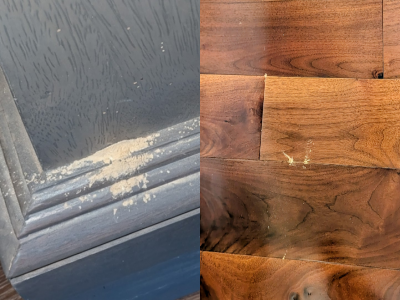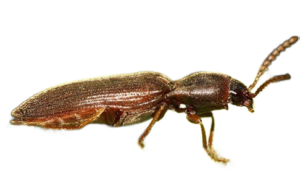Wood Boring Beetles
When addressing wood boring beetles, correctly identifying the specific beetle species is crucial. Some beetle species re-infest wood, while others do not. If the beetle species does not re-infest, no treatment is necessary; repairing the damaged wood will suffice.
Wood boring beetles can be identified through several methods:
- Capture and Inspection: Direct identification of the beetle.
- Frass Analysis: Examining the texture and composition of their droppings.
- Exit Hole Size: Noting the diameter of the exit holes left in the wood.
- Wood Type: Determining the type of wood being infested.
For re-infesting beetles that depend on moisture to survive, addressing the underlying moisture issue is the most critical step. Eliminating the moisture source will help prevent further infestations.
Treatment Options for Wood Boring Beetles
Treatment methods vary depending on the infestation severity and beetle species:
- Wood Replacement: Removing and replacing damaged wood.
- Liquid Treatments: Applying chemical solutions to eliminate beetles.
- Temperature Treatments: Using heat or cold to kill beetles.
- Fumigation: In severe cases, fumigation may be required. Note that fumigating for wood boring beetles requires significantly more gas—up to ten times the amount used for drywood termites.
 Powder Post Beetles
Powder Post Beetles
Powder post beetles are a serious problem because they can reinfest and are difficult to eliminate. The only way to perform a local treatment is with borates, but the wood must be unfinished. I have two customers dealing with them—one in her flooring and another in a cabinet. Both cases involve finished wood. The customer with the flooring has seen activity for over five years. To treat it, the flooring would need to be stripped, a borate solution applied, and then refinished. The other customer had no real option but to dispose of the cabinet.
The alternative is fumigation, but it requires about ten times more gas than a termite fumigation, making it very costly.
You can identify powder post beetles by their frass. Unlike termite droppings, which are gritty and sand-like, powder post beetle frass is fine and silky, resembling actual powder.
 Beetle Fumigation
Beetle Fumigation
When structural framing such as rafters, sill plates, and headers become infested with Powder Post Beetles or Old House Borers, the most effective treatment is fumigation. However, fumigating for beetles is significantly more expensive than fumigating for drywood termites due to the amount of gas required.
- Old House Borers require four times as much gas as a standard drywood termite fumigation.
- Powder Post Beetles require ten times as much gas.
The reason for the increased gas usage is that unlike termites, you must kill the insects inside the eggs. When termite adults die, their colony dies with them. But beetles can survive without adults, allowing eggs to hatch and reinfest the wood.
Because fumigators provide the underlying warranty (which means if the fumigation fails, they’ll re-fumigate at no cost), most fumigators only provide pricing upon request for beetle fumigation due to the increased costs and liability.



